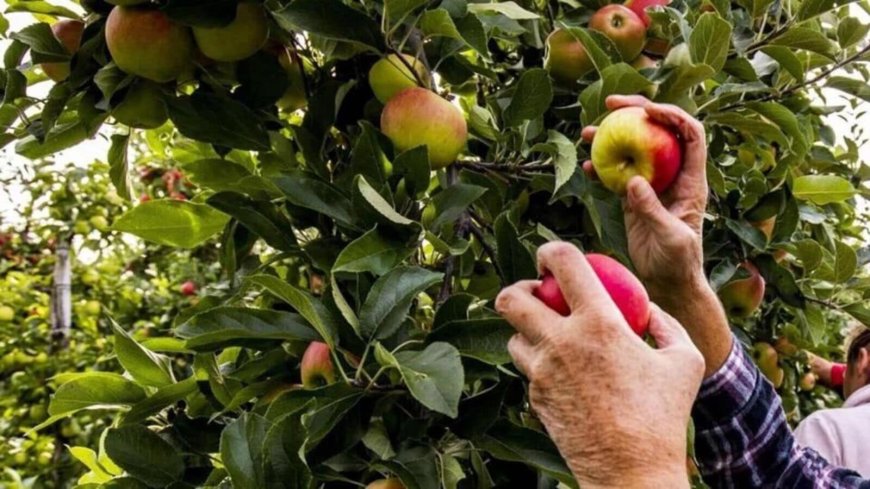Missing snow, too much rain: Himachal’s apple crop feels the squeeze
Himachal Pradesh's apple production faces a major setback in 2025 due to lack of snow and excessive rainfall. Explore the impact on farmers, prices, and future prospects.

Erratic Weather Patterns Threaten State’s Key Cash Crop, Worrying Farmers and Traders Alike
Shimla, July 16, 2025 —
Himachal Pradesh’s apple orchards, nestled in the picturesque Himalayan slopes, are facing one of their toughest seasons in recent memory. An unsettling combination of dwindling snowfall during winter and unseasonal, excessive rainfall during the monsoon has severely impacted the state’s famed apple crop. This twin blow from nature is not only jeopardizing livelihoods but also triggering alarms in the agricultural economy of the hill state.
Snow Deficit Derails Dormancy Cycle
Apple trees require a defined period of chilling — typically provided by winter snow — to ensure healthy flowering and fruit setting. However, the winter of 2024-25 witnessed an alarming 40-60% deficit in snowfall in key apple-producing regions such as Shimla, Kinnaur, and Kullu. The chilling hours fell drastically below the threshold of 1,000 to 1,200 hours needed for optimal flowering.
“Snow is essential for apple trees to enter their dormancy phase,” explains Dr. R.S. Minhas, horticulture scientist at Dr. YS Parmar University of Horticulture and Forestry, Solan. “Without adequate chilling, the flowering is erratic and delayed, leading to poor fruit setting.”
Excess Rain Worsens Orchard Woes
If the lack of snow wasn't damaging enough, the unusually intense pre-monsoon and monsoon rainfall in May and June dealt another blow to the orchards. Torrential rains have led to the proliferation of fungal diseases such as apple scab and powdery mildew, while also causing fruit drop and water logging in many areas.
“More than 30% of my apples have already dropped,” says Ashok Negi, a farmer from Kotkhai, Shimla district. “We expected a lower yield due to weak flowering, but this rain has crushed any hope of recovery.”
According to the State Horticulture Department, apple output in 2025 is projected to decline by over 40% from the previous year’s production of 6.7 lakh metric tonnes. Early estimates suggest the crop might not even cross 4 lakh metric tonnes this season.
Market Ripple Effects: Prices Up, Quality Down
Lower production has already pushed up wholesale and retail prices across major mandis. In Delhi’s Azadpur Mandi, early-season apples from Himachal are trading at ₹130-₹180 per kg, a sharp jump from ₹80-₹100 per kg during the same time last year. However, the quality of the produce has dipped due to poor coloration and fungal infections.
“Consumers are seeing smaller, pale apples with patchy skin,” says Pankaj Arora, a trader in Chandigarh. “This will hurt export potential too, as international buyers are very quality-conscious.”
The reduced supply and lower-grade fruits may force retailers and exporters to look for alternatives from Kashmir or imported varieties from the U.S. and New Zealand, though those options also come with logistical and pricing challenges.
Climate Change and the Shift in Apple Belts
This year’s crisis is not an anomaly but part of a growing trend linked to climate change. Over the past decade, Himachal Pradesh has seen a gradual shift in apple-producing belts to higher altitudes. Areas like Theog and Kotkhai, which once formed the core of the apple economy, are struggling, while upper reaches in Kinnaur and Lahaul-Spiti are seeing increased cultivation.
“Lower altitude areas are now unsuitable for traditional apple varieties,” notes Dr. Anjali Rana, environmental analyst at TERI. “There’s an urgent need for the introduction of climate-resilient apple varieties and advanced irrigation practices to safeguard this vital sector.”
Government Response and Farmer Expectations
In light of the unfolding crisis, the Himachal Pradesh government has promised relief. The horticulture department has begun conducting crop damage assessments, and officials have hinted at a potential compensation package.
“We are exploring subsidies for fungicide sprays and financial support for affected farmers,” said Horticulture Minister Jagat Singh Negi during a recent visit to Narkanda. However, many farmers are skeptical, citing delays in past compensation schemes and the lack of long-term planning.
“Every year we face nature’s wrath, and every year we hear empty promises,” laments Shanta Devi, a small orchard owner in Jubbal. “We need real insurance and infrastructure, not token relief.”
Investor Outlook: Cold Storage and Logistics in Focus
For investors and agritech players, the ongoing crisis underscores a growing need for investment in cold chain infrastructure, rainwater harvesting systems, and climate-resilient farming technologies.
“Companies offering drip irrigation, automated weather tracking, and disease forecasting tools could see increased demand in Himachal and similar geographies,” says Rajeev Kapoor, AgriTech analyst at Edelweiss Securities. “There’s also a growing opportunity in contract farming and private cold storage ventures.”
However, until systemic changes are adopted, both the farming community and the broader horticulture economy remain vulnerable.
The apple crisis in Himachal Pradesh is more than just a seasonal hiccup — it is a stark warning of the challenges posed by climate change to India’s fruit economy. As farmers grapple with the consequences of erratic weather, a coordinated response from the government, private sector, and scientific community is imperative. Without proactive measures, the “apple state” of India may find its prized fruit increasingly elusive in the years to come.
What's Your Reaction?
 Like
0
Like
0
 Dislike
0
Dislike
0
 Love
0
Love
0
 Funny
0
Funny
0
 Angry
0
Angry
0
 Sad
0
Sad
0
 Wow
0
Wow
0













































































